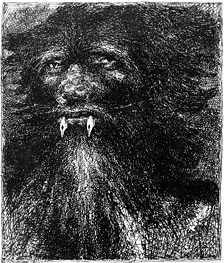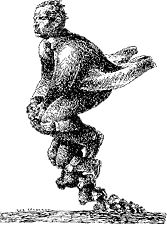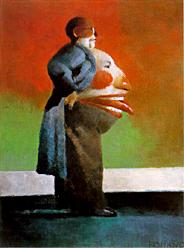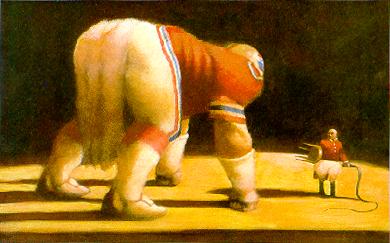



 Why is
it that the more I like an artist's work, the more difficult it
usually is to say "why" I like it? Brad Holland is like
that. And, as is quite often the case with my favorites, I cannot
recall when I first became aware of his work - it seems that it
was always there.
Why is
it that the more I like an artist's work, the more difficult it
usually is to say "why" I like it? Brad Holland is like
that. And, as is quite often the case with my favorites, I cannot
recall when I first became aware of his work - it seems that it
was always there.
Holland was born in 1943 and pretty much taught himself to draw. He remembers drawing his own comic books as a child and, at the age of seven, took it upon himself to rewrite the ending of the Iliad in the Classics Illustrated version. My guess is the Trojans won. As he grew older, he tried unsuccessfully to get work at the Disney Studios. (How many submissions do you figure they got per week from young would-be artists and animators?)
Left to his own devices for tutelage, he tried to reproduce the effects he saw in "charcoal" drawing with charcoal briquettes and he used model airplane paint to do his earliest color work. While the results haven't survived the years, he must have learned something from the efforts. By 1960 he was ready to leave home and head for the big city (Chicago) and make his mark on the art world.
Unfortunately, the art world didn't notice him. I would love to see what his portfolio looked like at that age. The drawings have been described as "apocalyptic" and with his raw skills coupled with some youthful intensity they must have been pretty powerful.
(I learn a lot from looking at the early work of an artist. It often reflects very directly the influences and emotions that helped shape them. This can sometimes lend insight into their later work. Plus the exuberance of youth and its I'll Show Them attitude usually makes for some pretty impressive images. Many early pieces by talented artists also display the benefit of time, a factor usually in very short supply later in their careers.)
A couple of years as an assistant to a Chicago artist (and other less "glamorous" jobs like tattooing and grocery stock boy) and Holland opted for a steady paycheck in the glamorous greeting card field. He moved to Kansas City to work for Hallmark. The early sixties constitute his schooling and apprenticeship years. The main art training he had was from John Dioszegi, the artist he worked for in Chicago, and those fellow artists at Hallmark. Does anyone have any of the cards he did? It would be most interesting to see his work from this period.
 |
 |
 |
| The Universal Baseball Association, Inc. June 1969 | New York Review of Sex and Politics #18, 1969 | Playboy's Ribald Classics #3, 1972 |
 In
1967, he went to New York. This is about when I first became aware
of his work. I bought a copy of The Universal Baseball Association,
Inc. off the newsstand in 1969 because I liked the cover.
This is the earliest Holland work that I have. His first New York
work was for the short-lived Avant Garde (1968-1971). It's
not in the two (#s 2 & 3) that I own, so it was probably in
the first issue. Then the issue of The New York Review of Sex
and Politics from 1969 hit the local head shops and I was
hooked. He attacked the underground movement with alacrity, contributing
to the East Village Other, Screw, The New York
Ace, Rat, Mobster Times, The Berkeley Barb, LA Free
Press and even a 1972 underground comic titled Tales n'
Tails for the One n' Every Yoyo.
In
1967, he went to New York. This is about when I first became aware
of his work. I bought a copy of The Universal Baseball Association,
Inc. off the newsstand in 1969 because I liked the cover.
This is the earliest Holland work that I have. His first New York
work was for the short-lived Avant Garde (1968-1971). It's
not in the two (#s 2 & 3) that I own, so it was probably in
the first issue. Then the issue of The New York Review of Sex
and Politics from 1969 hit the local head shops and I was
hooked. He attacked the underground movement with alacrity, contributing
to the East Village Other, Screw, The New York
Ace, Rat, Mobster Times, The Berkeley Barb, LA Free
Press and even a 1972 underground comic titled Tales n'
Tails for the One n' Every Yoyo.
When his paintings began to appear on books from the Science Fiction Book Club, like Beyond the Beyond (1969, above left), I was right there to order them. He had drawings published in The Evergreen Review, Redbook Magazine and others. His work began to appear in the Society of Illustrators annuals with #11 (1970) which features that first Avant Garde piece as well as three others.
I eventually realized that it was Holland whose work was gracing the Ribald Classics pages of Playboy magazine - of which I have dozens of samples. He started doing them in 1967, but my tear sheet copies lack dates and I can't pin them to particular years. But the collection in paperback form above is from 1972. The horned creature below is from about that era. For a personal account of his friendship and working relationship with Shel Silverstein, check out Shel Game.

 Also
in 1972 came the invitation from the new art director of The
New York Times Op-Ed Page, Jean-Claude Suares, to become one
of the regular illustrators of the page. Holland's art set a powerful
trend in political commentary, though he professes that his art
is not politically biased. Perhaps that is true. One of the aspects
of his art is his ability to synthesize a concept to its "core
image": that image and nothing more that coveys the message
most clearly. For it isn't always how well an artist renders that
makes him or her successful. More often it is what they have to
say with their art and how they say it. Many political cartoonists
made a comment about the underlings that were sacrificed in the
attempt to protect Richard Nixon from the Watergate scandal, but
only Holland said so much about them with his one drawing of the
gargantuan Nixon atop the shoulders of a falling tower of successively
smaller associates.
Also
in 1972 came the invitation from the new art director of The
New York Times Op-Ed Page, Jean-Claude Suares, to become one
of the regular illustrators of the page. Holland's art set a powerful
trend in political commentary, though he professes that his art
is not politically biased. Perhaps that is true. One of the aspects
of his art is his ability to synthesize a concept to its "core
image": that image and nothing more that coveys the message
most clearly. For it isn't always how well an artist renders that
makes him or her successful. More often it is what they have to
say with their art and how they say it. Many political cartoonists
made a comment about the underlings that were sacrificed in the
attempt to protect Richard Nixon from the Watergate scandal, but
only Holland said so much about them with his one drawing of the
gargantuan Nixon atop the shoulders of a falling tower of successively
smaller associates.
 Within
a very short span of five years, Holland had installed himself
as one of New York's important illustrators. It's a tribute to
his artistic clarity and the aforementioned skill of distilling
a message to its simplest form that he was accepted and acknowledged
so quickly. Even more amazing is his refusal to describe what
he does in words. He believes that the image should communicate
its message without additional input from the artist. If it can't
then the artist has failed his responsibility.
Within
a very short span of five years, Holland had installed himself
as one of New York's important illustrators. It's a tribute to
his artistic clarity and the aforementioned skill of distilling
a message to its simplest form that he was accepted and acknowledged
so quickly. Even more amazing is his refusal to describe what
he does in words. He believes that the image should communicate
its message without additional input from the artist. If it can't
then the artist has failed his responsibility.
Book illustrations followed. At left is a pen drawing from The Cowboy and the Cossack from 1973. Others were The Geek (1975) and Human Scandals, the amazing collection of his pen & ink work (1977).
 A
collection of his color work is long overdue. His dust jacket
for Gower Street won the Society of Illustrators Book Gold
Medal in the 1975 annual, and he won it again in 1977 for one
of his illustrations to The Geek. His list of awards is
simply too long to document here. Below is an image for which
he won the SoI Silver Medal in 1984. To the right is a Gold Medal
winner from 1997.
A
collection of his color work is long overdue. His dust jacket
for Gower Street won the Society of Illustrators Book Gold
Medal in the 1975 annual, and he won it again in 1977 for one
of his illustrations to The Geek. His list of awards is
simply too long to document here. Below is an image for which
he won the SoI Silver Medal in 1984. To the right is a Gold Medal
winner from 1997.

What's even more important is that his venues have expanded to include advertising, record albums, and most other forms of commercial art. His style is deceptively simple and often mimicked, but his visual simplicity, often relying on punning images, is either inadequate or inelegant in the hands of lesser artists. It's his mind in conjunction with his brush that makes Holland so special. Despite a myriad of approaches to a wide range of assignments, his art is instantly recognizable. I just did a double take last week to a picture in one of the computer magazines I subscribe to and, sure enough, Brad has found yet another venue.
 He
won the 1991 Hamilton King for the painting at left, "I'm
Coming Apart" and there is a wonderful conversation between
Brad and his longtime friend and fellow artist, Wendell Minor
in that Illustrators 33 annual. At one point the conversation
veers wildly into speculations on which historic artists might
have belonged to the Shriners. Holland muses, "I have a feeling
the Shriners would have begged (Picasso) to join and then encouraged
him not to attend meetings." That's the sense of humor that
comes through in much of his art. I like both.
He
won the 1991 Hamilton King for the painting at left, "I'm
Coming Apart" and there is a wonderful conversation between
Brad and his longtime friend and fellow artist, Wendell Minor
in that Illustrators 33 annual. At one point the conversation
veers wildly into speculations on which historic artists might
have belonged to the Shriners. Holland muses, "I have a feeling
the Shriners would have begged (Picasso) to join and then encouraged
him not to attend meetings." That's the sense of humor that
comes through in much of his art. I like both.
 To learn more about Brad Holland, see:
To learn more about Brad Holland, see:| 200 Years of American Illustration | Henry C. Pitz, Random House 1977 |
| Human Scandals | Brad Holland, Thomas Y. Crowell 1977 |
| The Illustrator in America 1880-1980 | Walt and Roger Reed, Madison Square, 1984 |
| Contemporary Graphic Artists volume 1 | Gale Research Company, 1986 |
| Illustrators 33 | Society of Illustrators, 1991 |
| The Vadeboncoeur Collection of Knowledge | Jim Vadeboncoeur, Jr. 2000 |
|
Illustrations are copyright by their
respective owners. This page written, designed & © 2000 by Jim Vadeboncoeur, Jr. Updated 2011. |
